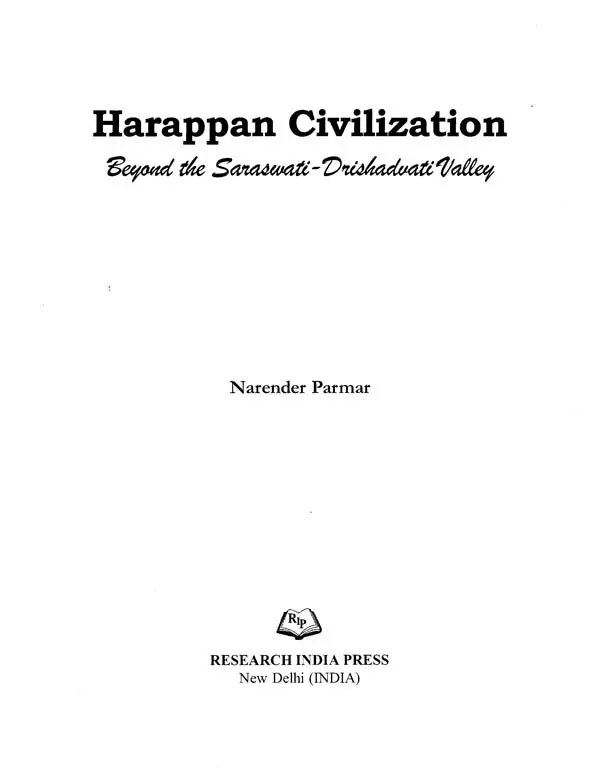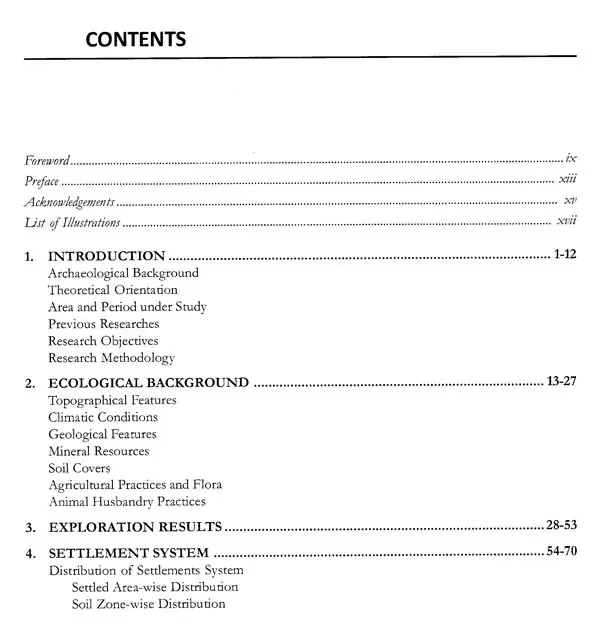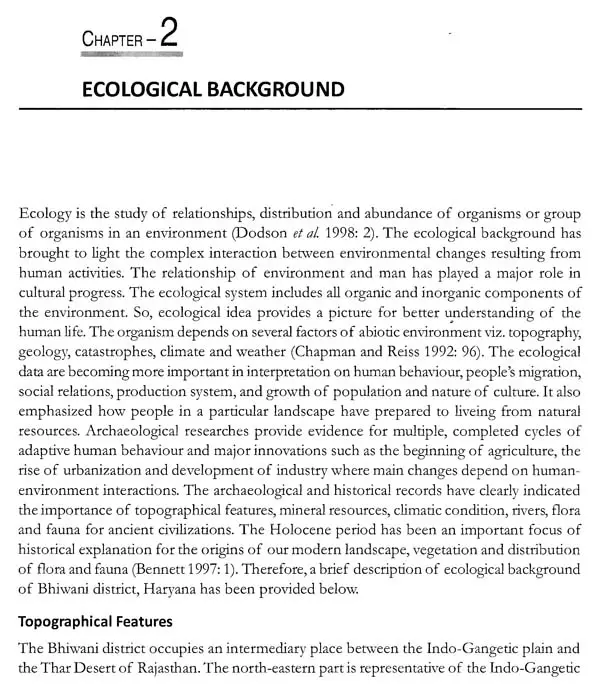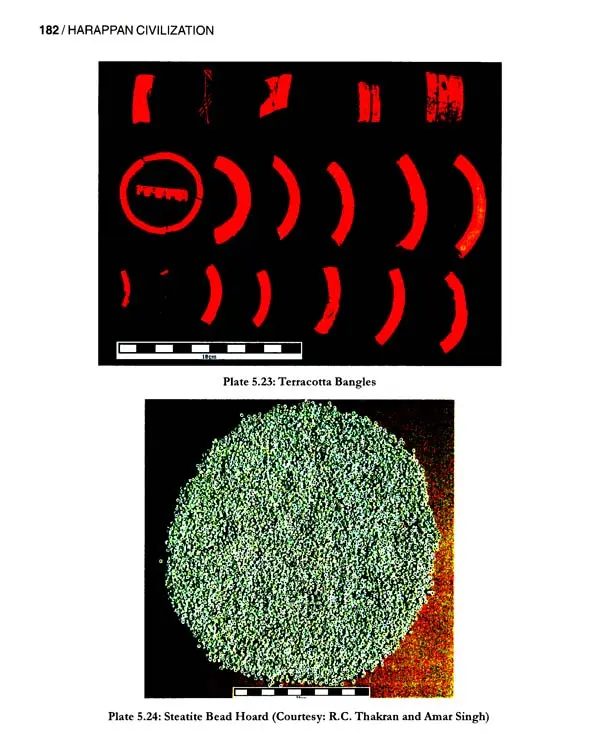
Harappan Civilization- Beyond the Saraswati-Drishadvati Valley
Book Specification
| Item Code: | UAJ762 |
| Author: | Narender Parmar |
| Publisher: | Research India Press |
| Language: | English |
| Edition: | 2019 |
| ISBN: | 9789351711438 |
| Pages: | 207 (Throughout color Illustrations) |
| Cover: | HARDCOVER |
| Other Details | 11.00 X 8.50 inch |
| Weight | 790 gm |
Book Description
The book highlights the socio-economic aspect of the Harappan civilization beyond the Saraswati-Drishadvati valley. The presence of fertile land, irrigation facilities and spatial distribution of the settlement system is clearly indicates that the upper Saraswati basin was most favourable region for the Harappan people. Apart from the favourable ecological conditions, the Harappans descended beyond the Saraswati-Drishadvati valley, especially in the semi-arid zone of Thar Desert and Aravalli outcrops (Southern Haryana). This region was devoid of fertile agricultural land and the irrigation facilities were nominal. However, a good number of the Harappan settlements emerged and developed in this region. The main contribution of this book is to investigate the cause of migration of the Harappans from the fertile land (Saraswati- Drishadvati valley) to the semi-arid zone (Thar Desert of Rajasthan), in-depth analysis of the cultural sequence and bring to light the nature of these settlements. In addition to this, the book also focuses on cultural transformations, settlement system, subsistence economy, ceramic assemblages and other cultural material of the Harappan civilization in the semi-arid zone.
Dr. Narender Parmar is a young archaeologist, specialized in the area of Harappan archaeology. field archaeology and settlement system. He did his Master Degree in History from M. D. University. Rohtak, Haryana and Master of Philosophy (M. Phil.) in Ancient Indian History, Culture and Archaeology from Kurukshetra University. Kurukshetra, Haryana. He has also in his credit the Post-Graduate Diploma in Archaeology from Institute of Archaeology (ASI), Red Fort, Delhi. Dr. Parmar completed his Ph. D. Degree in Archaeology from Deccan College Post Graduate and Research Institute, Pune.
Dr. Parmar participated in the excavations at Bhirrana, Manheru, Farmana, Masudpur, Badli, Meham, Lohat, Karsola, Chaturbujnathnala, Juaffardih, Ganeshwar and also independently conducted various exploration programmes in Haryana, Rajasthan and Punjab. In addition, he also carried out excavations at Tigrana, district Bhiwani, Haryana. He has published more than two dozen research papers in various international and national journals and vibrantly participated in conferences of National and International repute of historic academia emphasizing archaeology. Since the beginning of archaeological studies, he actively participated in lot of research projects which are led by Deccan College PGRI, Pune, Archaeological Survey of India, University of Delhi, University of Cambridge, Banaras Hindu University and Humanity and Nature Institute, Japan etc. He is also nominated as a non-official member of Haryana Academy of History and Culture by the Government of Haryana. Presently, Dr. Parmar is serving as a faculty member in the Department of History and Archaeology, Central University of Haryana, Mahendragarh, India.
The discovery of the Harappan Civilization in 1920s changed completely the perception of Indian history. This Civilization also filled in the gap between the Stone Age and Early Historic period providing continuous cultural sequence for last two million years. The Harappan Civilization flourished over a major part of north-west Indian sub-continent from 2600 BC to 1900 BC. It is characterized by the presence of cities and towns and a variety of different categories of sediments, a well planned grid pattern town planning with civic amenities, presence of a well developed craft specialization and unique material culture over such a vast area.
A large number of scholars and institutions are involved in uncovering and reconstructing history of this civilization, which has established the foundation of modern India. Over 2000 sites of this culture have been discovered so far and nearly 100 selective ones have been excavated on different scale. As a result of this, there is a large publication available on this Civilization. Of late it has been realized that the Civilization though presents a picture of standardization, there are a number of regional diversities noticed in their lifestyle. It perfectly presents a picture of unity in diversity which is exactly the composition of modern India. The regional diversity was first identified by J. P. Joshi and subsequently established by G.L. Possehl in Saurashtra. Similar diversity was also present in the Ghaggar Hakra basin (Vedic Saraswati region) which is being studied presently. The regional diversity is noticed in their settlement pattern, town planning, painted ceramic ornaments and subsistence pattern. The excavations carried out at Farmana and Rakhigarhi have thrown some light on this regional diversity in the Ghaggar basin.
The discovery of the Harappan Civilization (1921) led to the introduction of the first urban civilization of the Indian-subcontinent. A number of research investigations carried out so far have provided ample evidence on the superior town planning, fortified township, perfect agricultural scheme, long trade network, high quality technique, classical craft activities and mass production of the standard items. The extent of this civilization was greater in area than any other contemporary civilizations like the Egyptian and the Mesopotamian. The civilization was distributed over an area of 2, 17,557 million sq km, that includes the regions of Baluchistan, Indus river plain, Saraswati-Drishadvati valley, Cholistan, Sind, Kachchh and Saurashtra. However, the region of the Saraswati Drishadvati valley was most favourable for the Harappans. More than one thousand Harappan settlements are found in this region. Metropolitan city, urban centres, big villages, small villages, factory sites and trading camp sites appear to have increased in the upper Saraswati basin. Basically, this region provided excellent opportunities for the beginning and development of the Harappan civilization. The fertile land and well irrigation facilities of this region were well known for the surplus production of wheat, barley and rice etc and also provided much needed functional trade routes facilitating the smooth flow of trade items. The excavations at the sites of Kalibangan, Kunal, Bhirrana, Banawali, Rakhigarhi, Farmana and Balu are defining the characteristic features of Harappan civilization in the upper Saraswati basin.
Apart from the favourable ecological conditions, the Harappan people settled beyond the Saraswati-Drishadvati valley especially in the northern part of Thar Desert (Southern Haryana). The region occupies an intermediary place between the Indo-Gangetic plain and the Thar Desert of Rajasthan. The climatic conditions of this part of the world were not helpful for agricultural activities and salty nature of underground water was also not enough for the irrigation facilities Generally this region is characterised by cluster of varying sizes and shapes of sand-dunes of the Thar Desert. Nonetheless, a good number of the Harappan settlements appeared in the semi arid zone. Majority of these settlements survived in the form of small villages and were rural in nature. Not even a single urban settlement was found beyond the Saraswati-Drishadvati valley. The important d excavations at the Harappan sites of Mitathal and Manheru brought to light the socio-economic aspects of the Harappan civilization of this region. The traits of regional culture (Sothi Siswal culture) dominated in this region and classical Harappan material was found in very limited number. The presence of local objects, such as terracotta, stone, copper, bone, faience and steatite were more popular in this region compared to other precious and semiprecious objects. The burnt brick structures were totally absent and entire living structures were made of mud bricks. These situations themselves testify the economic condition of the Harappan settlements located beyond the Saraswati-Drishadvati valley Most probably, these settlements were not enjoying imperial life like urban settlements of the main Saraswati-Drishadvati valley.
**Contents and Sample Pages**












